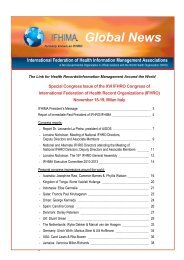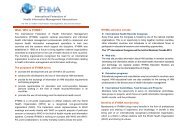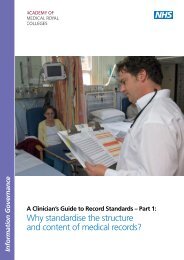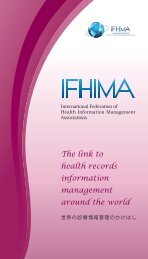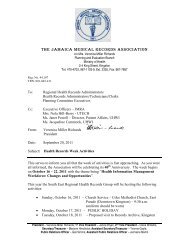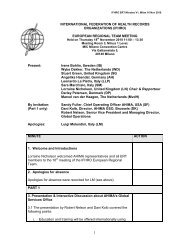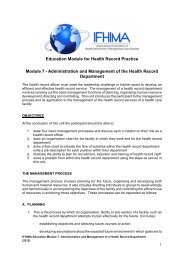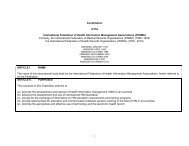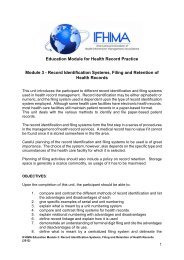Module 5a: Disease & Procedure Classification and ... - ifhima
Module 5a: Disease & Procedure Classification and ... - ifhima
Module 5a: Disease & Procedure Classification and ... - ifhima
You also want an ePaper? Increase the reach of your titles
YUMPU automatically turns print PDFs into web optimized ePapers that Google loves.
examination surveys, multiple cause analysis may be the only satisfactorymethod."b) Short lists for Tabulation of Mortality <strong>and</strong> Morbidity"recommends that the Special Tabulation Lists set out in Annex IV tothis report should replace the lists for tabulation of morbidity <strong>and</strong>mortality <strong>and</strong> should be published as part of the International<strong>Classification</strong> of <strong>Disease</strong>s together with appropriate explanation <strong>and</strong>instruction as to their use."These are all important issues <strong>and</strong> participants should read introduction pagesvery carefully. The section in the introduction relating to the actual manual <strong>and</strong>use of the ICD9, covers the following important points:a) Conventions used in the Tabular List the special use of parentheses <strong>and</strong>colons is explained <strong>and</strong> should be clearly understood before proceedingfurther. The main points are:"When parentheses are used for their normal function of enclosingsynonyms, alternative wordings or explanatory phrases, square brackets[...] are employed.""Round brackets (...) are used to enclose SUPPLEMENTARY wordswhich may be either present or absent in the statement of a diagnosiswithout affecting the code number to which it is assigned.""Words followed by a colon [:] are NOT COMPLETE TERMS, but musthave one or other of the understated modifiers to make them assignableto the given category.""NOS is an abbreviation for "NOT OTHERWISE SPECIFIED" <strong>and</strong> isvirtually the equivalent of "UNSPECIFIED" <strong>and</strong> "UNQUALIFIED"."The example on Page XXVI illustrates the above points <strong>and</strong> should becarefully reviewed by the participant before proceeding to the next point.b) Dual <strong>Classification</strong> of Certain Diagnostic StatementsThis is an innovation in the 9th Revision <strong>and</strong> relates to the use of TWO CODESfor certain diagnostic descriptions. These descriptions contain "elements ofinformation both about a localised manifestation or complication <strong>and</strong> a moregeneralised underlying disease process.That is, "one of the codes - marked with a dagger (+), is positioned in the part ofthe classification in which the diagnostic description is located according tonormal ICD principles, that is, the code relating to the underlying disease.The other marked with an asterisk (*) is positioned in the chapter relating to theorgan system to which the manifestation or complication relates.Example:Tuberculous meningitis has a dagger (+) code in the chapter for infectiousdiseases - 013.1+IFHIMA Education <strong>Module</strong> <strong>5a</strong>: <strong>Disease</strong> & <strong>Procedure</strong> <strong>Classification</strong> & Indexing ICD 94(2012)
<strong>and</strong> itsasterisk (*) code in the nervous system chapter - 348.8*The DAGGER <strong>and</strong> ASTERISK categories have been included to enable retrievalor statistical analysis of data from either viewpoint.It is important to note, however, that the DAGGER CATEGORY is the PRIMARYCODE <strong>and</strong> the ASTERISK code is SECONDARY. It is, therefore, importantwhen using both codes to clearly indicate which is which.There also are a number of important points relating to the dual system <strong>and</strong>although not reproduced here, the participant should read the pages verycarefully before proceeding.The dagger <strong>and</strong> asterisk systems is limited with only about 150 rubrics of each inwhich asterisk or dagger-marked terms occur. Again examples of these areclearly displayed.c) Role of the E CodeThe E code is a supplementary classification in ICD9 <strong>and</strong> may be used to codeEXTERNAL factors associated with morbid conditions classified to any part of themain classification.Before proceeding read the rest of the introduction in Volume 1 <strong>and</strong> make sureyou underst<strong>and</strong> clearly the important points relating to the:. conventions used in the Tabular list. dual classification of certain diagnostic statements, <strong>and</strong>. the use of the E Code2. List of Three-digit CategoriesThe next section of Volume 1 lists the three-digit categories which is theframework <strong>and</strong> basic unit of the classification system, which is used in somecountries for statistical grouping of diseases, the External Causes of Injuries <strong>and</strong>Poisoning, <strong>and</strong> Factors Influencing Health Status <strong>and</strong> Contact with HealthServices. The latter is referred to as the "V" code. Within this section, therefore,there are seventeen (17) sub-sections plus the "E" <strong>and</strong> "V" codes which aresubsequently exp<strong>and</strong>ed in the next section which is the Tabular list.3. Tabular List of Inclusions <strong>and</strong> Four-digit CategoriesThis is the major section of the classification primarily used to allocate the correctcode. The first seventeen "chapters" cover codes for the following:I. Infectious <strong>and</strong> Parasitic <strong>Disease</strong>sII. NeoplasmsIII. Endocrine, Nutritional <strong>and</strong> Metabolic <strong>Disease</strong>s, <strong>and</strong> Immunity DisordersIV. <strong>Disease</strong>s of the Blood <strong>and</strong> Blood-forming OrgansV. Mental DisordersVI. <strong>Disease</strong>s of the Nervous System <strong>and</strong> Sense OrgansIFHIMA Education <strong>Module</strong> <strong>5a</strong>: <strong>Disease</strong> & <strong>Procedure</strong> <strong>Classification</strong> & Indexing ICD 9(2012)5
VII. <strong>Disease</strong>s of the Circulatory SystemVIII. <strong>Disease</strong>s of the Respiratory SystemIX. <strong>Disease</strong>s of the Digestive SystemX. <strong>Disease</strong>s of the Genitourinary SystemXI. Complications of Pregnancy, Childbirth, <strong>and</strong> the PuerperiumXII. <strong>Disease</strong>s of the Skin <strong>and</strong> Subcutaneous TissueXIII. <strong>Disease</strong>s of the Musculoskeletal System <strong>and</strong> Connective TissueXIV. Congenital AnomaliesXV. Certain Conditions originating in the Perinatal PeriodXVI. Symptoms, Signs <strong>and</strong> Ill-defined ConditionsXVII. Injury <strong>and</strong> PoisoningThen follows:. Supplementary <strong>Classification</strong> of External Causes of Injury <strong>and</strong> Poisoning- "E" Codes. Supplementary <strong>Classification</strong> of Factors Influencing Health Status <strong>and</strong>Contact with Health Services - "V" Codes. Morphology of Neoplasms <strong>and</strong>,. <strong>Classification</strong> of Industrial Accidents According to AgencyEach one of these sections will be dealt with individually later in this Unit.4. Medical Certification <strong>and</strong> Rules for <strong>Classification</strong>The term morbidity means "illness", morbidity coding is the coding of episodes ofillness usually in a hospital setting. The purpose of coding in a hospital setting,i.e. supplying data for research, education <strong>and</strong> evaluation means that hospitalcoders are often interested in capturing every illness which the patient has. Ofcourse some patients do die in hospital <strong>and</strong> their records are coded in the sameway as the other patients except that an autopsy may make possible moredetailed coding.Mortality coding is the coding of a cause of each death. From the community'sviewpoint it is important to know why people die <strong>and</strong> from what illnesses thesurviving population suffer.The first classification systems were concerned with classifying causes of death.The problem of collecting information on cause of death is commonly solved by asystem where a death certificate is completed by a medical practitioner.The WHO is concerned that the procedure for the completion of deathcertificates <strong>and</strong> the selection of underlying cause of death is uniform around theworld. The section on "Medical Certification <strong>and</strong> Rules for <strong>Classification</strong>" is animportant section of ICD9. It clearly defines the designation of the UNDERLYINGCAUSE OF DEATH <strong>and</strong> describes the use of the International form of medicalcertificate of Cause of Death.The form of medical certificate consists of two parts as follows:IFHIMA Education <strong>Module</strong> <strong>5a</strong>: <strong>Disease</strong> & <strong>Procedure</strong> <strong>Classification</strong> & Indexing ICD 9(2012)6
I. (a) Direct cause(due to)(b) Intervening antecedent cause(due to)(c) Underlying antecedent causeII.Other significant conditions contributing to the death but not related to thedisease or condition causing it.With this certificate in PART I THE CAUSE LEADING DIRECTLY TO DEATH isstated on line (a) <strong>and</strong> the antecedent conditions, lines (b) <strong>and</strong> (c) which GAVERISE TO THE CAUSE follows. THE UNDERLYING CAUSE BEING STATEDLAST IN THE SEQUENCE OF EVENTS.IF the disease or condition directly leading to death specified in (a) describescompletely the train of events leading to death NO entry is necessary on lines (b)<strong>and</strong> (c).PART II covers "other significant conditions which unfavourably influence thecourse of the morbid process, <strong>and</strong> thus CONTRIBUTED to the fatal outcome,BUT which was not related to the disease or conditions directly causing death."The important point relating to the completion of the medical certificate of causeof death, is in the SELECTION of the UNDERLYING CAUSE.Participants should read this section very carefully. The 12 rules which apply tothe selection of the underlying cause are clearly explained with examples of eachrule.Notes for use in underlying cause mortality coding for interpretation of entries ofcauses of death should also be read along with the section on PerinatalMortality <strong>and</strong> Morbidity.As mentioned previously, this is an important section <strong>and</strong> is often overlooked bybusy health record workers <strong>and</strong> statisticians.5. Special Tabulation ListsThis section has three lists:. the Basic Tabulation List. Mortality List of 50 Causes. Morbidity List of 50 CausesThe Basic Tabulation List consists of 57 two-digit rubrics which add up to the "allcauses" total.These lists can be used for the national display of morbidity <strong>and</strong> mortality data bycountries, but to ensure a minimum of international comparability, any tabularlists used for these purposes should contain the 50 rubrics of the attachedMorbidity <strong>and</strong> Mortality Lists.Morbidity statistical collections also require a single condition for national analysisof the data. The principal diagnosis is the item which is analysed in morbidityIFHIMA Education <strong>Module</strong> <strong>5a</strong>: <strong>Disease</strong> & <strong>Procedure</strong> <strong>Classification</strong> & Indexing ICD 97(2012)
statistical collections. To make the collection consistent it is necessary for ast<strong>and</strong>ard definition of principal diagnosis to be adopted for the collection. WHOgives some guidelines for the formulation of such definitions in ICD9. WHOwishes to encourage local development of st<strong>and</strong>ard recording methods whichincorporate these WHO criteria.The morbidity/mortality distinction is therefore tied to the difference betweensingle <strong>and</strong> multiple coding. Multiple coding presents some difficulties <strong>and</strong> it isimportant that a coding policy of the national morbidity statistical collection beestablished. Quality coded data can only be achieved by the consistentapplication of coding policy which has been formulated at a local level. The ICD9is open to interpretation <strong>and</strong> an effort must be made to ensure that a highlevel of consistency is achieved by coders.The rules here also state that any list used for mortality data MUST be based oncoding according to aetiology. That is, if the dual code is used, data must bebased on the DAGGER code. Morbidity lists, however, may be based on eithercoding method (aetiology or manifestation), but the method used MUST beclearly stated when publishing data.6. Definitions <strong>and</strong> RecommendationsC. ICD9 - VOLUME 2The final section in Volume 1 deals with Definition <strong>and</strong> Recommendations, someof which you will also find in the previous unit.Volume 2 is the alphabetical index to Volume 1 <strong>and</strong> participants should carefully read theintroduction, which includes the general arrangement of the Index <strong>and</strong> conventions usedin the index.By reading this section participants will gain an underst<strong>and</strong>ing of the main sections <strong>and</strong>structures of the index as well as the conventions relating to parentheses,cross-references, abbreviations <strong>and</strong> special signs.The alphabetical index follows the introduction <strong>and</strong> has three sections:Section IAlphabetical Index to <strong>Disease</strong>s <strong>and</strong> Nature of InjuryThis section will allow you to locate codes for the seventeen chapters, <strong>and</strong> the M <strong>and</strong> Vcodes. It is therefore the most frequently used section <strong>and</strong> the largest the volume.Section IIAlphabetical Index to External Causes of InjuryAs the description "External Causes of Injury" implies, this section refers not to medicaldiagnoses, but to the circumstances under which the violence or accidents occur.Section IIIAlphabetical Index to Drugs <strong>and</strong> Other Chemical Substances (Table ofDrugs <strong>and</strong> Chemicals)This section is displayed as a table <strong>and</strong> gives codes for substances used in poisoning.The substances are listed alphabetically with the code from Chapter 17 <strong>and</strong> various Ecodes from which the coder must choose the most suitable. This organisation allowsthe coder to choose both with one alphabetical reference.IFHIMA Education <strong>Module</strong> <strong>5a</strong>: <strong>Disease</strong> & <strong>Procedure</strong> <strong>Classification</strong> & Indexing ICD 98(2012)
The index is organised into two columns. At the head of the column is a lead term whichis usually the name of a disease, that is, a noun. Under the term various modifying terms(adjectives) are listed. These modifiers may be the various sites at which this diseaseoccurs or particular varieties of the condition. The introduction to Volume 2 explains thisarrangement.A list of corrections (corrigenda) for Volume 1 is included in Volume 2.The alphabetical index is very important <strong>and</strong> SHOULD BE USED AT ALL TIMES inconjunction with Volume 1.Participants should NOT get into the habit of only using one of the volumes. They MUSTbe used concurrently as errors occur when coders bypass the index or bypass thetabular list. If you want to code efficiently, effectively <strong>and</strong> accurately, you must get intothe habit of using ICD9 correctly.We will now take a more detailed look at Volume 2 lists <strong>and</strong> code some exercises toassist with the learning process.D. CODING PROCEDUREWithin each of the 17 chapters in Volume 1 the codes are organised in numerical orderaccording to a uniform format. This is followed by notes which apply to the wholechapter. These notes indicate what is included in or excluded from the chapter. Eachchapter is divided into sections. The section title is printed in the centre of the page inlight type (upper case) with the codes for that section appearing in brackets. Thethree-digit code is printed in bold type on the left h<strong>and</strong> margin with the title for that codeappearing beside it. The fourth digits are then listed. Underneath the codenumber the inclusion terms for that code are listed [for example, under code003.0, Salmonellosis is listed].Inclusion terms are just some of the diseases which are classified here. The inclusionterms are not an exhaustive list of all diseases included in the code number. There aremany diseases listed in the alphabetic index which are listed as inclusion terms inVolume 1.Information contained at the fourth digit level may represent a variety of the disease,different sites or other information; [for example, duration (acute or chronic). Code 002,Typhoid <strong>and</strong> paratyphoid fevers, is divided at the fourth digit level into types of thedisease. However, code 006, Amoebiasis, reflects the site of amoebic abscesses at thefourth digit level].Some codes are three digits in length <strong>and</strong> are not subdivided into four digit codes, [forexample Code 037, Tetanus]. Where fourth digit subdivisions are provided they must beused. A THREE DIGIT CODE IS ONLY USED IF NO FOURTH DIGITS HAVE BEENPROVIDED.1. Coding <strong>Procedure</strong>To code a disease using ICD9, follow these steps:a) Decide on the lead term in the diagnosis, i.e. the noun in the diagnosiswhich is the name of the disease, not the site of the disease.IFHIMA Education <strong>Module</strong> <strong>5a</strong>: <strong>Disease</strong> & <strong>Procedure</strong> <strong>Classification</strong> & Indexing ICD 99(2012)
) Locate the lead term in the alphabetical index (Volume 2) <strong>and</strong> then checkthe list of modifiers for any remaining words (adjectives) in the diagnosis.c) Check the code given in the index with the entry in the tabular list(Volume 1). In this step you are checking for exclusion notes which maychange your decision to use the code.As mentioned previously it is ESSENTIAL THAT BOTH BOOKS BE USED TOALLOCATE THE CODE, because there may be an exclusion note in Volume Iwhich will change your decision to use the code. Exclusion notes must befollowed <strong>and</strong> you should check for exclusion notes at both the fourth digit level<strong>and</strong> the three digit level of the code.To code 'stenosis of the duodenum' first recognise that the lead term will bestenosis, not duodenum, i.e. THE NAME OF THE DISEASE NOT THE SITE.Turn to the entry for stenosis <strong>and</strong> look through the modifiers listed under thisterm until you locate duodenum. The code given is 537.3 <strong>and</strong> when this code ischecked in Volume 1 there is no exclusion note preventing its use <strong>and</strong> so 537.3is the correct code for stenosis of the duodenum.Remember that the coding procedure is composed of two parts:-. the analysis of the health record to determine what items shouldbe coded <strong>and</strong>. the allocation of correct codes.These two activities are not independent because a thorough reading of therecord is necessary to bring to light evidence regarding the patient which mayaffect the choice of codes.2. Which sections of the health record are analysed by the coder?As a minimum:1. the front sheet2. the discharge summary3. operation report4. histopathology report for any tissue removed.Other sections of the record which are useful in choosing the correct codeinclude:1. pathology reports - for example to identify the bacteria or virusresponsible for an infection - pneumonia, gastro-enteritis2. x-ray reports - for example to specify site of fracture3. progress notes - for example to determine the principal diagnosis if notclear on the front sheet or discharge summary4. previous admissions. Coders usually check that all previous admissionsIFHIMA Education <strong>Module</strong> <strong>5a</strong>: <strong>Disease</strong> & <strong>Procedure</strong> <strong>Classification</strong> & Indexing ICD 910(2012)
have been coded3. How many diseases <strong>and</strong> operations will be coded?The level of detail to be coded varies some what from hospital to hospital, <strong>and</strong>country to country. Large teaching hospitals often need to collect detailedinformation on the type of diseases for research <strong>and</strong> teaching. Small hospitalsmay choose to code only the principal diagnosis on each admission.As a minimum, the principal diagnosis <strong>and</strong> principal procedure should be coded.Most hospitals will also code diseases treated during the admission <strong>and</strong> everyprocedure performed. For research purposes some hospitals will also code rarediseases which the patient has, even if these have not been treated during theadmission <strong>and</strong> rare, unusual or expensive procedures, even if these are notbeing performed in an operating theatre.To start you coding, turn to the next page <strong>and</strong> complete Exercise 1. Answers are in Appendix1.Copyright © 2012 by the International Federation of Health Information Management Associations.The compilation of information contained in these modules is the property of IFHIMA, which reserves all rightsthereto, including copyrights. Neither the modules nor any parts thereof may be altered, republished, resold, orduplicated, for commercial or any other purposesIFHIMA Education <strong>Module</strong> <strong>5a</strong>: <strong>Disease</strong> & <strong>Procedure</strong> <strong>Classification</strong> & Indexing ICD 9(2012)11



